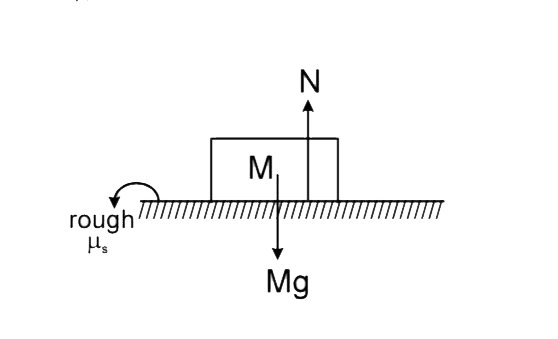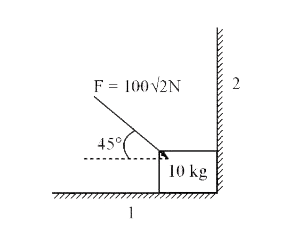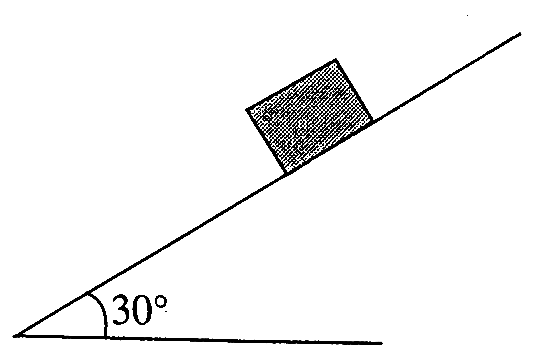For a block kept on a table, the maximum force of static friction is . If the set-up is taken to moon, the force is . Then
none of these
The correct Answer is:c
To solve the problem, we need to understand the relationship between the maximum force of static friction and the gravitational force acting on the block. The maximum force of static friction can be calculated using the formula:
Fmax=μs⋅N
where:
- Fmax is the maximum static friction force,
- μs is the coefficient of static friction,
- N is the normal force acting on the object.
1. Identify the Forces on Earth:
- When the block is on the table on Earth, the normal force N is equal to the weight of the block, which is given by N=mg, where m is the mass of the block and g is the acceleration due to gravity on Earth (approximately 9.8m/s2).
- Therefore, the maximum static friction force F1 on Earth can be expressed as:
F1=μs⋅mg
2. Identify the Forces on the Moon:
- When the same block is taken to the Moon, the normal force N will now be N=mg′, where g′ is the acceleration due to gravity on the Moon (approximately 1.6m/s2).
- Thus, the maximum static friction force F2 on the Moon can be expressed as:
F2=μs⋅mg′
3. Compare the Forces:
- Now, we can compare F1 and F2:
F1=μs⋅mgandF2=μs⋅mg′
- Since g>g′ (because g≈9.8m/s2 and g′≈1.6m/s2), we can conclude that:
F1>F2
4. Final Conclusion:
- Therefore, the maximum force of static friction on Earth F1 is greater than the maximum force of static friction on the Moon F2:
F1>F2
- Fmax is the maximum static friction force,
- μs is the coefficient of static friction,
- N is the normal force acting on the object.
- When the block is on the table on Earth, the normal force N is equal to the weight of the block, which is given by N=mg, where m is the mass of the block and g is the acceleration due to gravity on Earth (approximately 9.8m/s2).
- Therefore, the maximum static friction force F1 on Earth can be expressed as:
F1=μs⋅mg
- When the same block is taken to the Moon, the normal force N will now be N=mg′, where g′ is the acceleration due to gravity on the Moon (approximately 1.6m/s2).
- Thus, the maximum static friction force F2 on the Moon can be expressed as:
F2=μs⋅mg′
- Now, we can compare F1 and F2:
F1=μs⋅mgandF2=μs⋅mg′
- Since g>g′ (because g≈9.8m/s2 and g′≈1.6m/s2), we can conclude that:
F1>F2
- Therefore, the maximum force of static friction on Earth F1 is greater than the maximum force of static friction on the Moon F2:
F1>F2
Topper's Solved these Questions
- FRICTIONBOOK - CENGAGE PHYSICSCHAPTER - FRICTIONEXERCISE - CONSOLIDATED EXERCISE.
1 Videos
- FRICTIONBOOK - CENGAGE PHYSICSCHAPTER - FRICTIONEXERCISE - CONSOLIDATED EXERCISE. (MULTIPAL-CHOICE QUESTION WITH ONE OR MORE THAN ONE CORRECT ANSWER)
3 Videos
- FRICTIONBOOK - CENGAGE PHYSICSCHAPTER - FRICTIONEXERCISE - OLYMPIAD AND NTSE LEVEL EXERCISES (Read the given statements and select the correct option.)
1 Videos
- ELASTICITYBOOK - CENGAGE PHYSICSCHAPTER - ELASTICITYEXERCISE - OLYMPIAD AND NTSE LEVEL EXERCISES
10 Videos
- SOUNDBOOK - CENGAGE PHYSICSCHAPTER - SOUNDEXERCISE - OLYMPIAD AND NTSE LEVEL EXERCISE
10 Videos
Similar Questions
Knowledge Check
The maximum static frictional force is
AEqual to twice the area of surface in contactBIndependent of the area of surface in contactCEqual to the area of surface in contactDNone of the aboveA block of mass 2kg is kept on the floor. The coefficient of static friction is 0.4 . If a force F of 2.5N is applied on the block as shown in the figure, the frictional force between the block and the floor will be.
 A2.5NB5NC7.84ND10N
A2.5NB5NC7.84ND10NA homogeneous block rests against a vertical wall for which the coefficient of friction is 1/2. A force 'F' is applied to the block in the direction as shown in figure. Find the maximum magnitude of applied force 'F' such that block remains in rest.
 AmgB5mgCmg/5Dmg/2
AmgB5mgCmg/5Dmg/2
What is value of static friction force on the block?

View SolutionA block is lying static on the floor.The maximum value of static frictional force on the block is 10N .If a horizontal force of 8N is applied to the block,what will be the frictional force on the block ________ (in N) (g=10ms2)
View SolutionA force F is applied on a block kept at the smooth surface in contact with the wall. If the block is at rest, the forces applied by block on surface (1) is F1 and on surface (2) is F2. Find F1F2 (Take g=10 m/s2)

View Solution
Figure shows a block kept on a rough inclined plane. The maximum external force down the incline for which the block remains at rest is 1 N while the maximum external force up the incline for which the block is at rest is 7 N. The coefficient of static friction μ is:
View SolutionA block of mass 4 kg is kept on a rough horizontal surface. The coefficient of static friction is 0.8. If a force of 19 N is applied on the block parallel to the floor, then the force of friction between the block and floor is
View Solution
